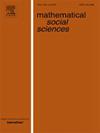A stricter canon: General Luce models for arbitrary menu sets
IF 0.5
4区 经济学
Q4 ECONOMICS
引用次数: 0
Abstract
Alós-Ferrer and Mihm (2025, Corollary 1) recently provided a characterisation the classical Luce model (Luce, 1959) when choices are observed for an arbitrarily restricted collection of menus, as is typical in experimental settings or when working with field data. They also characterise the general Luce model (ibid., Theorem 1), which allows choice probabilities to be zero, for the same setting. The latter characterisation involves a single axiom – the general product rule (GPR). An important special case of the general Luce model is obtained when the mapping from menus to the support of choice probabilities can be rationalised by a weak order. Cerreia-Vioglio et al. (2021) show that this special case is characterised by Luce’s (1959) choice axiom, provided choice is observed for all possible (finite) menus. The choice axiom is thus a fundamental “canon of probabilistic rationality”. We show that a natural – and surprisingly simple – strengthening of the GPR characterises the model of Cerreia-Vioglio et al. (2021) when the menu set is arbitrarily restricted. Our axiom implies the choice axiom, and is therefore a “stricter canon”.
更严格的标准:用于任意菜单集的通用Luce模型
Alós-Ferrer和Mihm (2025, Corollary 1)最近提供了经典Luce模型(Luce, 1959)的特征,当在任意限制的菜单集合中观察选择时,这是典型的实验设置或使用现场数据时。它们还描述了一般的Luce模型(同上,定理1),该模型允许在相同的设置下选择概率为零。后一种描述涉及到一个公理——一般乘积法则(GPR)。得到了一般Luce模型的一个重要特例,即从菜单到选择概率支持的映射可以通过弱顺序进行合理化。Cerreia-Vioglio等人(2021)表明,这种特殊情况的特征是Luce(1959)的选择公理,前提是所有可能的(有限的)菜单都有选择。因此,选择公理是一个基本的“概率理性的经典”。我们表明,当菜单集被任意限制时,Cerreia-Vioglio等人(2021)的GPR模型具有自然且令人惊讶的简单强化特征。我们的公理包含了选择公理,因此是一个“更严格的准则”。
本文章由计算机程序翻译,如有差异,请以英文原文为准。
求助全文
约1分钟内获得全文
求助全文
来源期刊

Mathematical Social Sciences
数学-数学跨学科应用
CiteScore
1.30
自引率
0.00%
发文量
55
审稿时长
59 days
期刊介绍:
The international, interdisciplinary journal Mathematical Social Sciences publishes original research articles, survey papers, short notes and book reviews. The journal emphasizes the unity of mathematical modelling in economics, psychology, political sciences, sociology and other social sciences.
Topics of particular interest include the fundamental aspects of choice, information, and preferences (decision science) and of interaction (game theory and economic theory), the measurement of utility, welfare and inequality, the formal theories of justice and implementation, voting rules, cooperative games, fair division, cost allocation, bargaining, matching, social networks, and evolutionary and other dynamics models.
Papers published by the journal are mathematically rigorous but no bounds, from above or from below, limits their technical level. All mathematical techniques may be used. The articles should be self-contained and readable by social scientists trained in mathematics.
 求助内容:
求助内容: 应助结果提醒方式:
应助结果提醒方式:


